Best beach tents in 2024, tried and tested
Content is created by CNN Underscored’s team of editors who work independently from the CNN newsroom. When you buy through links on our site, CNN and its syndication partners may earn a commission. Learn more
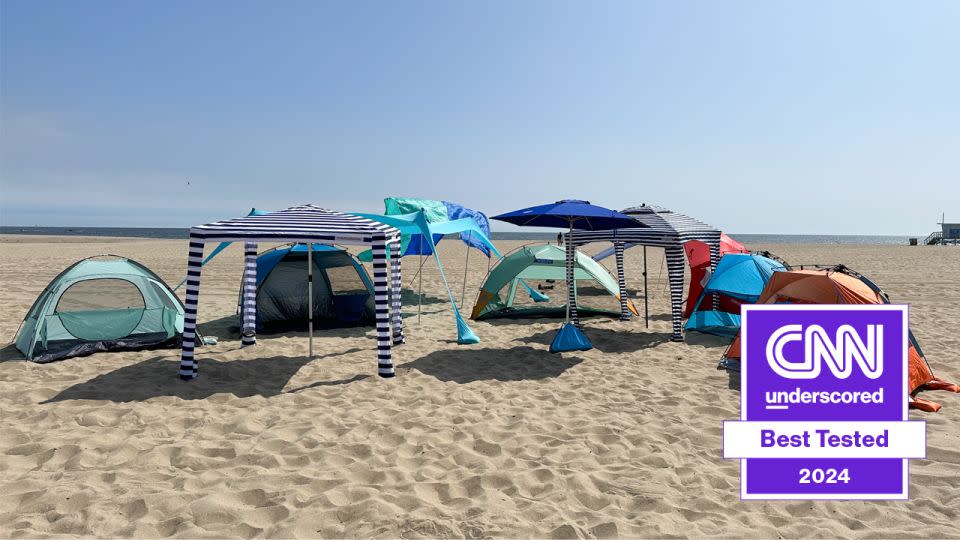
Those clear, sunny skies that welcomed you to the beach at 10 a.m. can quickly become unbearable by noon when even the most diligent sunscreen appliers and sun hat wearers can be affected by the sun’s heat and harmful UV rays. To ensure your beach day is as comfortable as possible, and to minimize the risks of sun exposure, consider utilizing a beach tent. These handy shelters provide you and your companions shade from the sun and a convenient home base for your supplies. Beach tents (or cabanas, shades and umbrellas) come in various sizes and are designed with portability in mind, making them relatively simple to set up and pack up at the end of the day.
I researched and got my hands on 12 popular models in a range of styles — including tents, shades, cabanas and umbrellas — to determine which is the best for the average beachgoer. After taking each for a day at the beach, examining their portability, usability, functionality and coverage, I found two beach tents that can help keep anyone comfortable and protected at the beach all day long.
Qipi Beach Cabana
Best beach tent
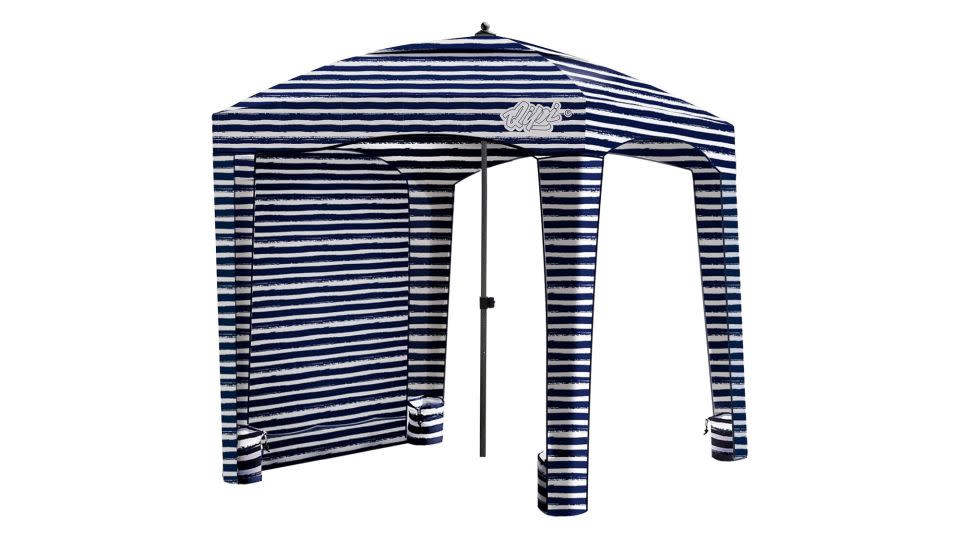
One of the breeziest yet most wind-resistant tents we tested, the user-friendly Qipi Beach Cabana is also simple to set up, providing a comfortable and sturdy shelter in just a few minutes.
Oileus XL Beach Tent
Best budget beach tent
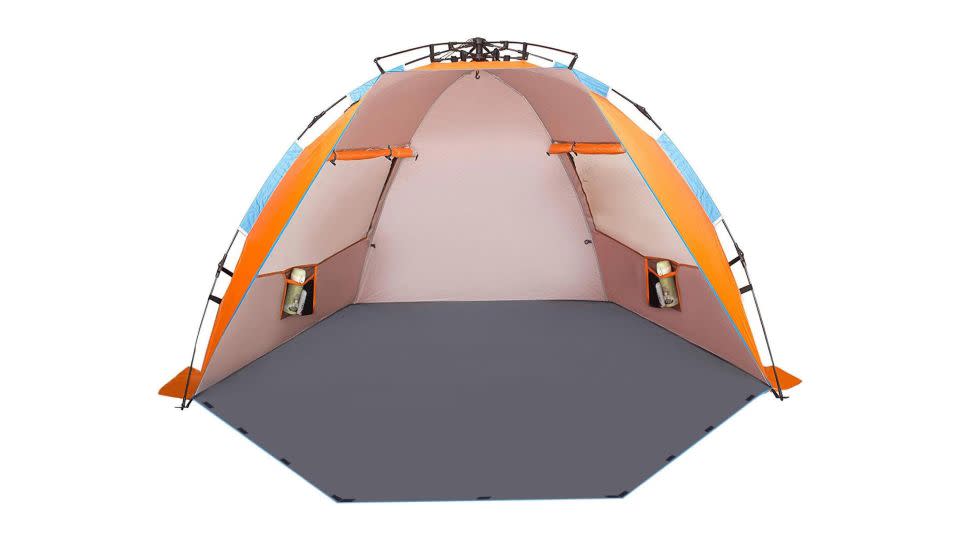
Although it lacks the ventilation and easy access of our top pick, the Oileus XL Beach Tent still provides a sturdy, wind-resistant design, an instant setup mechanism and multiple privacy features — all at a surprisingly low price.
Best beach tent: Qipi Beach Cabana
$121 $80 at Amazon or $100 at Outdoor Master
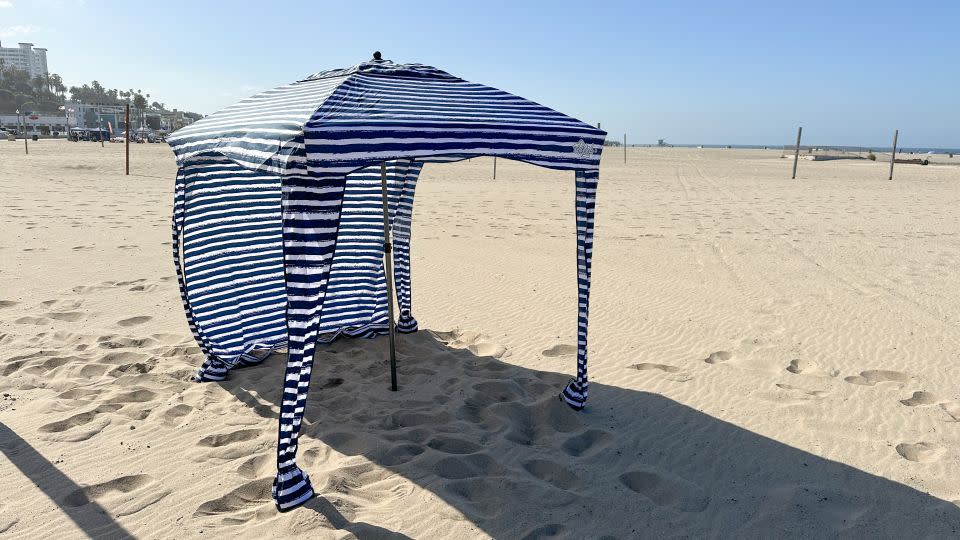
Combining an ultra-sturdy design, a user-friendly setup process and impressive functionality, there’s not much to dislike about the Qipi Beach Cabana. When you first get to the beach, you don’t want to spend 30 minutes or more just setting up your tent, which is why we love how fast it is to get the Qipi up and ready. It only has two components to work with (an auger-tipped support pole and the folded canopy), and to set it up all you have to do is screw the support pole into the ground, slide in the canopy rod and fill the four sandbags at the base of each leg. That’s it. Breaking it down at the end of the day was just as easy; dump the sandbags and reverse the process.
Each of the four legs features a mesh storage pocket at about waist height, which is convenient for keeping items like your phone, sunscreen, snacks or drinks out of the sand. My favorite feature of this cabana, and why it stood out above the rest (including the very similar CoolCabana 5), is its detachable wall. The top of this section clips easily to the cabana frame, and sandbags along the bottom keep it in place. Not only does this extra wall provide more shade and wind protection, but it also allows you to move it from one side to another as the sun changes position. Although the CoolCabana 5 provides a slightly larger canopy (79 square inches versus 72 inches), this additional wall gave the edge to the Qipi Beach Cabana in the overall coverage category. Both the canopy and the wall section of the Qipi Beach Cabana also offer UPF 50+ sun protection, which allows less than 2% of UV rays to pass through.
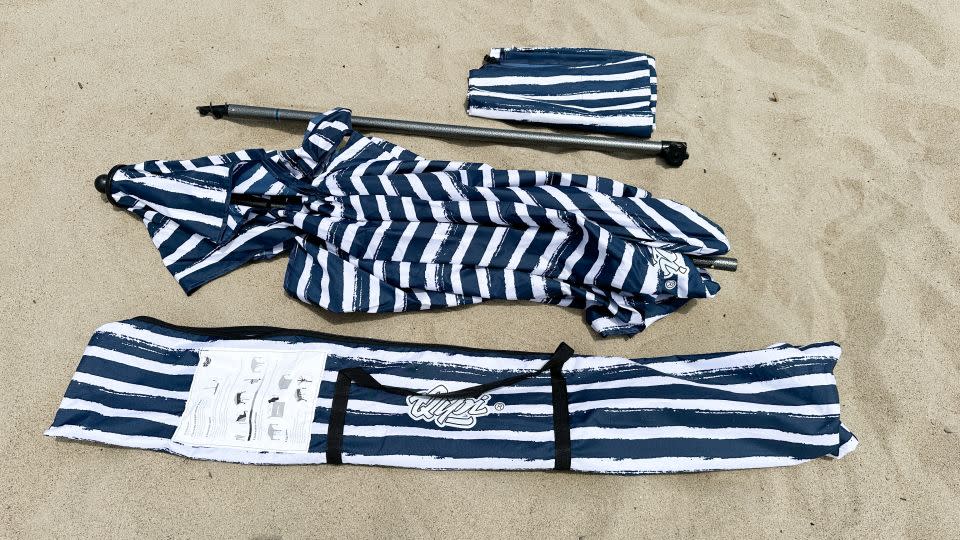
The metal support poles and thick fabric of the Qipi Beach Cabana give it a sturdy, solid feel, and I failed to notice any obvious durability issues during the setup, testing and breakdown process. Plus, unlike many other models I tested, the storage bag is well made and sturdy, featuring wide, well-stitched suitcase-style handles. If any workmanship or material defects arise, Outdoor Master’s two-year limited warranty should cover you if you buy the Qipi from the site.
The main drawback of the Qipi Beach Cabana is its portability, or rather, lack thereof. Measuring 57.5 inches long when packed up (the longest of any model I tested) and 10.4 pounds, this won’t be the best option if easy transport is your top priority. The CoolCabana 5 weighs about the same but packs into a significantly less bulky 38-inch package. That model costs $100 more, so it’s up to you if the added portability is worth the price.
If you’re interested in a sturdy, stable structure that is easy to set up, provides an impressive amount of sun protection without taking up too much space on the beach and costs less than $100, the Qipi Beach Cabana is the pick for you.
Best budget beach tent: Oileus XL Beach Tent
$100 $65 at Amazon
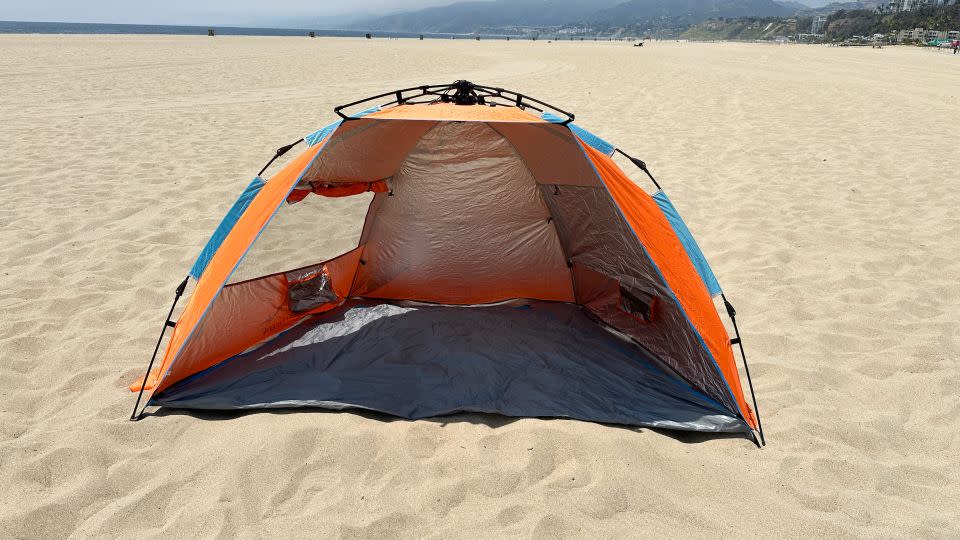
Despite the budget-friendly price, the Oileus XL Beach Tent still provides plenty of functionality. Not only is it as wind-resistant as the higher-end options I tested, but it’s also incredibly easy to set up. After removing it from the included storage bag, you simply pull the circular hub on top to extend the support poles, locking the structure in place. After filling the six built-in sandbags, this tent stands sturdy and strong, even with the wind blowing straight at it. If you need to anchor it in place even more, eight steel stakes and guylines are also included.
This sandbag layout — and resulting superior stability — was a primary reason the Oileus XL Beach Tent won out over similar tents like the WhiteFang 3-Person Beach Tent (only four corner sandbags) and E-Z Up Wedge Beach and Sport Tent (its side-mounted bags left the corners vulnerable to lifting in the wind).
The other factor that made the Oileus XL Beach Tent a superior choice to similarly priced models was the material of its floor section. Unlike the crinkly, noisy, camping-tarp-style floors of the Pacific Breeze Easy Setup Beach Tent and E-Z Up Wedge Beach and Sport Tent, this tent’s floor has a smoother, tighter weave, which makes it much more comfortable to lie down on. Also, unlike the slightly tacky texture of the WhiteFang 3-Person Beach Tent and Kelty Cabana, the Oileus’ floor is smooth enough to brush sand off easily. This floor panel extends outward to create more protection from the sand or folds up to cover the tent’s opening for maximum privacy.
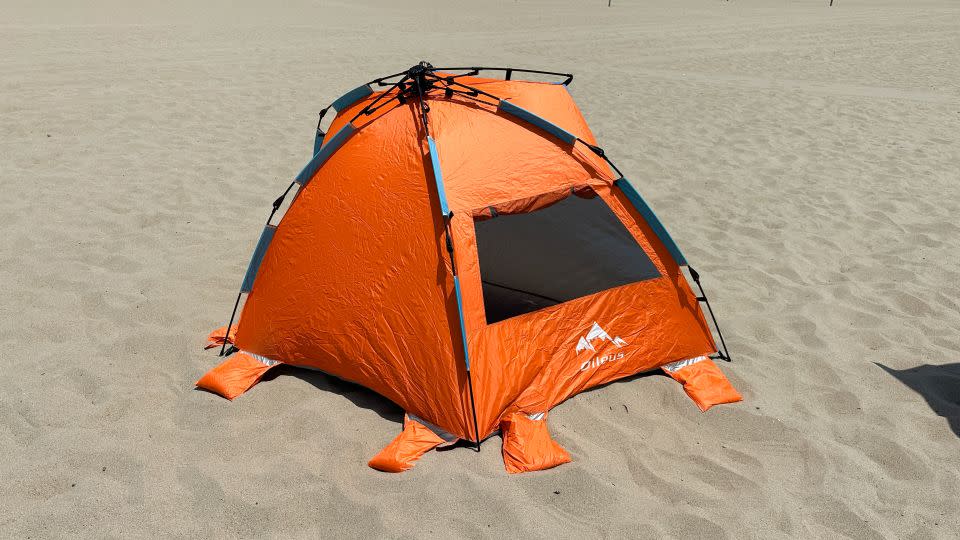
The wide, 92-inch entrance also makes the Oileus XL Beach Tent convenient to access, and inside, two large mesh windows provide breezy ventilation (and can be covered with a roll-up shade if you prefer). Two mesh storage bags underneath the windows are another helpful perk.
The 32-inch length of the storage bag is also relatively short compared to other tents (although not as compact as the 17.4-inch WhiteFang 3-Person Beach Tent or 26-inch Kelty Cabana), and weighing just 4 pounds, is convenient to transport and store when not in use. Unfortunately, like the rest of the lower-priced tents I tested, the strap on this storage bag is relatively flimsy and lacks the reinforced stitching you’d expect on a weight-bearing seam.
But if you’re on a tight budget and interested in the instant setup and privacy benefits of a pop-up tent, the Oileus XL Beach Tent is a great option.
What type of beach tent should I choose?
Beach tents, cabanas, shades and umbrellas all have their pros and cons, so make sure you choose the one that best suits your specific needs.
Tents: These three-sided structures provide the most protection from sun and wind, as well as extra privacy for changing clothes and diapers or concealing your belongings when going for a dip. While some tents use collapsable poles for support (like a traditional camping tent), pop-up versions have a built-in frame that expands in seconds, making them convenient for those who want to minimize setup time. Built-in sandbags weigh down the tent to prevent it from blowing away, and due to their light weight, they are easy to move around while still fully assembled.
Cabanas: Tall and open-sided, cabanas are convenient to walk in and out of, and compared with other shelters — excluding umbrellas — have a relatively small footprint. This open design allows wind to flow through without much resistance, and combined with the sturdy support pole and four legs with built-in sandbags, makes them especially sturdy. Some, like the Qipi Beach Cabana, offer removable walls for added shade and privacy.
Sun shades: These extra-large shelters provide a ton of coverage, and their wide-open design is convenient to enter and exit. Assembly and setup can be challenging, though, and requires some basic problem-solving skills to position them correctly. Open-ended options, such as the Shibumi Shade Classic, actually require wind to give them their shape, so the proper setup angle is especially important. Since sun shades require a lot of space to set up, they’re not practical for crowded beaches.
Umbrellas: Umbrellas have the smallest footprint, making them the best choice for those who don’t want to take up a lot of space on the beach. A reliable beach umbrella can withstand serious wind speeds if they have a sturdy, secure base (like the Beachbub All-in-One Beach Umbrella).
Do beach tents protect you from UV rays?
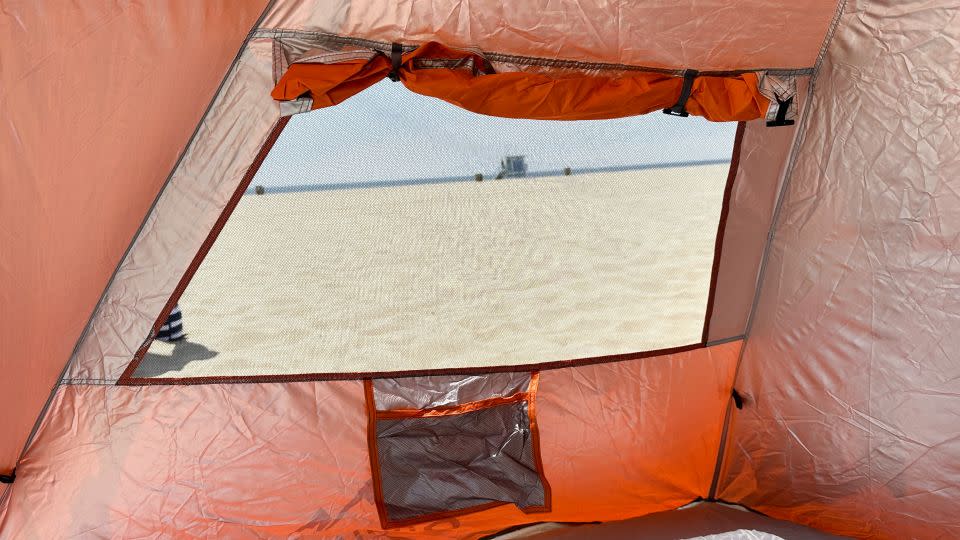
Even short-term exposure to UV radiation can be harmful, and depending on your skin type, cause a sunburn in just 10 to 15 minutes. Prolonged, cumulative exposure is also the leading cause of skin cancer, making it especially important to protect yourself at the beach. To ensure your beach tent provides adequate protection, look for options with a specific UPF (ultraviolet protection factor) rating. This number indicates the amount of UV radiation the material allows to pass through, with UPF 50+ being the most effective, blocking 98% of UV rays. For reference, a white cotton T-shirt has a UPF rating of about 5, allowing 20% of UV to pass through. For more information on the best fabrics for sun protection, REI does a good job of breaking down these ratings and other factors to keep in mind.
How we tested
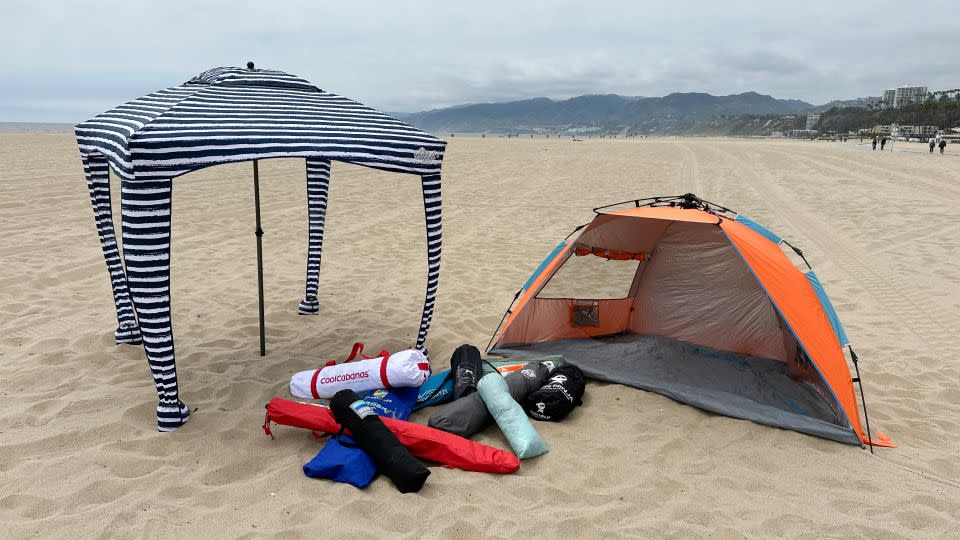
I ran each model through a comprehensive testing program to determine the best overall beach tent and recommend certain models for specific use cases.
Usability
Setup: I first assembled each tent right out of the packaging on the beach, only using the provided instructions. I noted how simple they were to set up, as well as how much physical effort was required to position them in place. I also compared how easy each tent was to disassemble and pack into its storage bag at the end of the day.
Instructions: I evaluated how informative and helpful any included instruction manuals were and noted if they were conveniently printed on the tent or storage bag, or on loose paper that could easily blow away on the beach.
Accessories: While exploring the features and capabilities of each tent, I also evaluated the functionality and overall usefulness of any windows, doors or storage pockets.
Comfort: I also compared each tent’s overall comfort as I spent time inside. I noted if the entrance required me to stoop down low to get in, if flapping material in the wind was annoying or if the structure was too cramped to position myself the way I wanted.
Portability
Size: I compared the overall size of each tent when folded down and ready for transport, which gave me a clear idea of the models that were significantly longer or bulkier than others.
Weight: I also weighed each tent when folded up, which gave me a clear idea of which options to recommend for those who would prefer not to lug around any extra weight.
Transport: Finally, I carried each tent to and from the beach, comparing how comfortable the straps and handles were on the included storage bags, or if they were awkward and imbalanced while carrying.
Coverage
Shade: During my beach tests, and through online research, I compared the overall amount of shade provided by each tent. I made sure to include not just the ceiling of each model but also any permanent or removable walls.
UV protection: I also researched and compared any specific UV protection features of each tent’s material. I found it interesting to learn that, while most tents boasted about their UV protection capability, not all provided an actual UPF rating.
Construction
Stability: During and after assembly, I took the time to closely examine and evaluate how each model withstood moderate wind speed. I also paid close attention to how well the anchoring system — like sandbags, tent stakes and support poles — worked (or didn’t work). While some flapping and waving of the material is expected, this allowed me to anticipate which models would work better than others in high-wind situations.
Materials: During and after assembling each tent, as well as through online research, I compared each tent’s canopy material and stitching, connections of umbrella ribs and construction of any rigid framing. I noted if the construction felt solid and sturdy or cheap and flimsy, paying close attention to smaller, plastic components that could fail over time.
Other beach tents we tested
WhiteFang 3-Person Beach Tent
$50 $40 at Amazon
Although this tent takes more work to set up than pop-up options, its ultra-low price could be worth the compromise. A pair of crisscrossing fiberglass rods provides the necessary structure — I assembled and threaded these through the panel sleeves in about five minutes — and four sandbags attached to each corner kept the tent firmly in place. Since these rods collapse when not in use, this tent’s storage bag is only 17.4 inches long, considerably more portable than many others. Unfortunately, just like the Kelty Cabana, the floor of the WhiteFang is made from a material that is practically a sand magnet and is difficult to brush off. The other tents lacked this problem, with the Oileus XL Beach Tent having the smoothest floor of all, and was a breeze to shake off when it was time to leave.
Pacific Breeze Easy Setup Beach Tent
$65 at Amazon
This tent uses the same pop-up “hub system” as the E-Z Up Wedge Beach and Sport Tent and Oileus XL Beach Tent, and is extremely simple to set up right out of the bag. At 87 inches across and 49 inches deep, it’s also the most compact of the three and would be a better choice for those who don’t want to take up much space on the beach. Although the corner sandbags did a great job of keeping the tent stable (unlike the E-Z Up Wedge Beach and Sport Tent, whose sandbags are located on the sides) and the two large roll-up windows provide breezy ventilation, the floor wasn’t the most comfortable to lie down on. The polyethylene material has a thick, crinkly, camping tarp feel that wasn’t as relaxing as the much smoother floor of the Oileus XL Beach Tent. Unfortunately, like the other pop-up-style tents, the storage bag strap’s lack of reinforced stitching doesn’t bode well for its long-term durability.
E-Z Up Wedge Beach and Sport Tent
$99 From $49 at E-Z Up
This pop-up-style tent looks very similar to the Pacific Breeze Easy Setup Beach Tent and Oileus XL Beach Tent, but I found it to be noticeably less stable in windy conditions. This was due to the position of the sandbags — in the center of the side walls as opposed to the corners — which allowed the corners to rise off the ground when the wind blew from the front. This can be remedied by using the included ground stakes, but that’s an extra step that similar tents didn’t require. The 95-inch-long opening and 51-inch depth provide more square footage than all the tents I tested, excluding the 116-by-76-inch Kelty Cabana. It also boasts a CPAI-84 fire code rating for flame resistance — the only option in my testing pool to do so — making it a great choice for those planning on attending any beach bonfires.
Kelty Cabana
$110 at Kelty
Like the WhiteFang 3-Person Beach Tent, this tent uses collapsable fiberglass poles instead of a pop-up design, so be prepared for some light-duty assembly. As long as you’re comfortable with about 10 minutes of work, the high-quality construction and spacious interior (the 116-inch opening and 76-inch depth provide more surface area than any other traditional tent I tested) are worth the effort. Despite this large size, the Kelty Cabana is also extremely portable when packed up, and fits into a storage bag just 26 inches long. Plus, unlike the flimsy, cheap bags of the Pacific Breeze Easy Setup Beach Tent, E-Z Up Wedge Beach and Sport Tent, and Oileus XL Beach Tent, this one is exceptionally sturdy, with reinforced stitching, sturdy zippers and an adjustable shoulder strap. Unfortunately, sand stuck to the floor of this tent worse than any other option I tested, and was a real challenge to brush off when packing it up. It’s important to note that this tent was the only model in my testing pool that failed to provide a UPF rating.
Sun Ninja Beach Tent Sun Shelter
$160 From $130 at Amazon
Assembly isn’t as straightforward as the other options on our list, but if you’re comfortable with a steeper learning curve, the impressive coverage size could be worth the extra effort. Unlike the pop-up-style tents and cabanas, the Sun Ninja Beach Tent Sun Shelter requires you to stretch out the spandex canopy on the sand first, fill the sandbags on each leg, then position the four support posts inside to prop it in the air. Getting the posts and legs positioned just right can take a little trial and error, so ideally you have a partner to help stabilize them as you work. The open sides and wide-set legs provide a ton of ventilation — and provide easy access in and out — but also create a large footprint, so it wouldn’t be practical for use on a crowded beach with limited space.
Shibumi Shade Classic
$270 $250 at Shibumi
The minimal design of this wind-powered shade provides maximum ventilation and access — no walls or windows or ceilings to duck under — and would be a great option for those who prefer not to be crowded under a canopy or inside a tent. The helpful illustrated instructions make setup a breeze, and once you understand the concept — wind unfurls the canopy, which creates shade — it works well. It’s got just three steps to set up: Thread a long tent pole through the edge of the canopy, jam the ends of the pole into the sand to form an arch and use the storage bag (conveniently attached to the canopy via rope) as the sandbag to keep the structure from blowing over. The entire kit weighs less than 4 pounds and measures just 27 by 4 inches when packed. The main drawback of this shade is that without any wind, the canopy droops down from the pole, and you lose your shade (although for $27 Shibumi offers sandbags that can be attached to pull the canopy taut, even in no wind).
Neso Tents Beach Tent
$105 at Amazon
A lower-budget alternative to the other stretch-style shade I tested (the Sun Ninja Beach Tent Sun Shelter), the Neso Tents Beach Tent is simple to set up and take down but lacks the quality construction of the higher-end Sun Ninja. Instead of a one-piece design, the Neso uses ropes to connect the spandex canopy to the four corner sandbags. This appears to compromise the structure’s integrity, and the extra stress on the sandbag stitching was already beginning to unravel and pop during my testing. This was a shame because I found the Neso fairly easy to set up, thanks to the simple instructions printed on the storage bag, and the 7-by-7-foot canopy stretched out to cover a lot of ground. This canopy isn’t as large as the Sun Ninja, but it still has plenty of room for two to four people, and it’s easier for a single person to set up.
CoolCabana 5
$200 at CoolCabanas
This 79-by-79-square-inch cabana provides 43 square feet of coverage (a bit more than the 72-sqaure-inch Qipi Beach Cabana). Although the clear, illustrated instructions attached to the storage bag did a great job walking you through each step in the setup process, the stake-style center pole was noticeably more challenging to plant in the sand than the auger-style pole of the Qipi Beach Cabana. I certainly wouldn’t consider this a deal breaker, but those with strength issues or working with especially hard sand may have trouble. The 38-inch carrying bag is short enough to transport and store without much hassle, and the canvas material and heavy-duty carrying straps are of noticeably high quality. Although I felt the Qipi Beach Cabana was the better choice at half the price, this is a fine alternative if you want more space and don’t mind paying for it.
Sport-Brella Premiere Umbrella
From $47 at Amazon
Although the 8-foot canopy of the Sport-Brella Premiere Umbrella provides a decent amount of protection at a budget-friendly price, confusing directions and low-quality materials kept it out of a top spot. The auger-style support pole was easy to screw into the ground, but its plastic construction seems especially vulnerable to snapping or bending, especially since it’s meant to be pushed over to position the canopy against the ground. Another concerning issue was the instruction sheet, which was vague and mistakenly instructed me to attach the canopy to the auger pole and then twist the entire unit into the ground — not the most efficient process. At 8 pounds, the Sport-Brella Premiere Umbrella is heavier than most other options. Although that might help with stability, it makes the flimsy storage bag’s strap even more of a liability.
Beachbub All-in-One Beach Umbrella
From $157 at Amazon
This heavy-duty beach umbrella offers serious stability, and its high-quality components are durable enough to last. It uses a large sandbag as the base, cleverly designed with a hole in the bottom for the umbrella pole to fit through. Metal grommets on the corners of the sandbag then slide onto hooks on the pole for a super-sturdy connection. Unfortunately, the collar that holds these hooks in place was slightly misshapen in my shipment, which prevented it from fitting completely flush. It still functioned fine but was unexpected considering the high price tag and high-end materials like thick fiberglass umbrella ribs and aluminum poles. Despite the straightforward assembly, the Beachbub All-in-One Beach Umbrella also inexplicably provides three sets of instructions, each with different information, sometimes one set contradicting another. While this umbrella is heavier than other options, its 9-pound weight is more manageable due to the super-thick and heavy-duty storage bag, which features a comfortable padded shoulder strap.
Note: The prices above reflect the retailers' listed price at the time of publication.
For more CNN news and newsletters create an account at CNN.com

